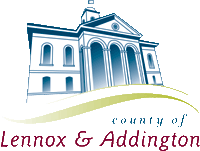
Villages & Entrepreneurs (1840-1860)Archibald McNeil's Ledger |
|||
|
|||
Archibald McNeil's Campbell House Account Ledger |
In the 1850's, Alexander Campbell, Napanee's postmaster and popular general merchant, operated a store in a two storey frame building on the southwest corner of Dundas and Centre Streets. He also published the Napanee Standard, local organ of the Conservative Party, from this location. DISCOVER MORE![]()
By the 1850's, the commercial district was advancing westward, away from the old East Ward. In 1856, the first Grand Trunk train had rumbled over the newly built river viaduct to the station in the Village. The Addington Colonization Road was pushing the frontier further north. A new town hall, in brick with classical proportions, had been built north of Dundas Street, between John and Centre Streets.
Buoyed by the optimism and prosperity of the decade, Alexander Campbell decided to develop two lots on the northwest corner of Dundas and Centre Streets that he had purchased several years before from John S. Cartwright. By 1859, an elegant Italianate-styled hotel had been built on this pivotal corner that lead west to Belleville, and north to the hinterland.
The hotel fašade as illustrated on A.B. Perry's 1859 Plan of Napanee was divided by a projecting frontispiece, crowned with an ornamented pediment and columns above the eaves. Two rows of three windows either side balanced the fašade. The frontispiece was pierced by a lunette in the topmost storey, an eight paned window on the third floor, a French door opening to a balcony on the second floor and deep entrance, defined by columns, on the ground level. Whimsical gargoyles peered down from the ornamented hood moulds above the balcony door and third floor window. Panelled French doors with a transom light were set into the entrance. Windows were eight paned, fitted with stone sills and ornamented with curved hood molds. The fascia, pierced with paired lunettes between paired eave brackets, then topped with a wide eave trimmed with a heavy molded cornice. The ground floor fašade was stone, fitted with arched entrance and windows openings.
In 1860, Alexander Campbell, now a partner in the Napanee Savings Bank Society, moved his general store from the old colonial era building on the south side of the street to the Campbell House corner store. He continued to offer a variety of clothing, boots and shoes and dry goods, but now in a bourgeois setting. His recently built handsome stone residence on the escarpment south of the river, befitted a Squire. The following year, a new liquor store opened in the shop in the Campbell House. By 1861, the hotel was advertised as "now open". The proprietor Abel Yates advertised well aired and furnished rooms, single meals for 25 cents and room and board for a $1.00 per day.
In 1866, Archibald McNeil purchased the Campbell House at auction for $8300. In the spring of 1869, he added a three storey west wing along Dundas Street and a two storey north wing along Centre Street. The wings are plain in comparison to the main structure, with stone voussoirs over the windows facing Dundas Street.
The McNeil ledger documents the visitors and business transactions of the Campbell House hotel. The ledger, kept by Archibald McNeil, between 1867 and 1870, records the amount owed by hotel visitors for services such as board, food and drink, and horse attendance. Many prominent men, women, and organizations were guests at the hotel. Visitors included doctors, judges, merchants, musicians, carpenters, and artisans.
The 1874 Birds Eye View of Napanee shows the main building with wings. Behind the hotel were spacious yards with a stable and driveshed. Marsden and Moore, proprietors, in 1876 extolled the Campbell House as the principal hotel in town, with good stabling and attentive hostler.
Disaster struck on November 25, 1883 during the proprietorship of Andrew Leslie when a serious fire broke out in Peter Hick's grocery in the west end. The fire spread rapidly through the post office, billiard room and barber shop on the ground floor. The west wing had been constructed without partywalls. The hotel rooms in the upper stories of the west wing were destroyed. The front wall fell, filling half of the street with debris. The fire gained access to the main building via two openings when the west wing was added. However, the old part of the hotel building was mostly saved. Losses were significant, estimated at $15,000 on the building and $5,000 worth of furniture.
© Lennox & Addington County Museum & Archives
97 Thomas Street East, Napanee, Ontario, Canada K7R 4B9
Funding provided by the Government of Ontario and the County of Lennox & Addington




